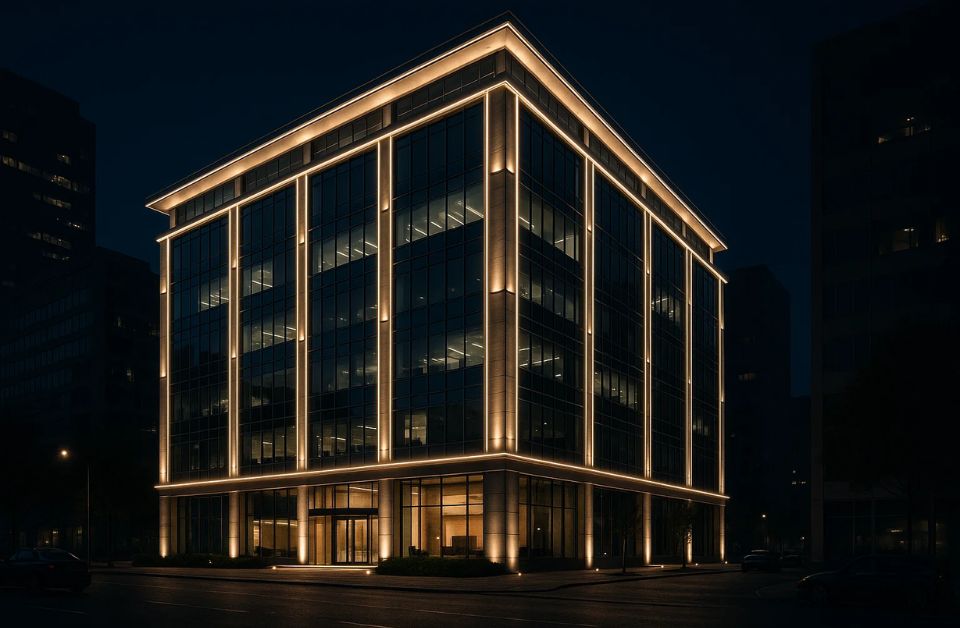Modern architecture is not just about how a building looks during the day. With the right lighting, buildings can come alive after sunset, turning into visual landmarks that enhance the cityscape. This is where facade lighting solutions play a transformative role. From commercial towers to luxury hotels, and from heritage monuments to shopping malls, facade lighting redefines architecture, blending function, design, and innovation.
In this blog, we’ll explore what facade lighting is, its types, benefits, technologies, and how it completely transforms buildings into timeless masterpieces.
What Is Facade Lighting?
Facade lighting refers to architectural outdoor lighting systems designed to illuminate the exterior surface (facade) of a building. These solutions highlight architectural details, enhance visual appeal, improve safety, and create a unique identity for the structure.
It is not only about making a building brighter, but also about:
- Emphasizing textures, shapes, and patterns of the exterior.
- Reflecting the brand identity of commercial spaces.
- Adding beauty to public spaces and urban skylines.
- Balancing aesthetics with energy efficiency and sustainability.
Types of Facade Lighting Solutions
Facade lighting can be applied in various creative ways depending on the design goals:
1. Grazing Light
- Light is projected at a sharp angle to emphasize surface textures.
- Ideal for stone, brick, or patterned exteriors.
2. Floodlighting
- Powerful beams that wash the entire facade in light.
- Commonly used for hotels, stadiums, and monuments.
3. Linear LED Lighting
- Continuous LED strips are installed along edges or architectural lines.
- Creates clean, modern, and futuristic looks.
4. Spotlighting
- Focused beams directed at specific architectural features.
- Highlights statues, signage, or building entrances.
5. Dynamic & RGB Lighting
- Uses DMX-controlled LEDs for color-changing and animated effects.
- Popular for malls, bridges, and event venues.
Benefits of Facade Lighting Solutions
Implementing facade lighting provides multiple functional and aesthetic benefits:
- Enhanced Visual Appeal – Buildings stand out as architectural icons.
- Improved Brand Image – Especially for hotels, retail stores, and offices.
- Increased Safety & Security – Well-lit exteriors reduce dark spots.
- Energy Efficiency – LED-based facade lighting reduces energy consumption.
- Tourism & Economic Value – Iconic lit buildings attract visitors and photographers.
How Facade Lighting Transforms Buildings?
1. Creates Nighttime Identity
By day, buildings rely on their architecture, but at night, lighting defines their identity. Facade lighting makes them recognizable landmarks in the skyline.
2. Highlights Architectural Features
Arches, columns, domes, and textures gain prominence through carefully placed lights, enhancing design details that may go unnoticed in daylight.
3. Supports Brand Storytelling
For commercial buildings, lighting can reflect brand colors, special occasions, or corporate identity. For example, a retail store may light up in festive colors during holidays.
4. Adds Functional Value
It improves safety around building perimeters while creating a welcoming environment for visitors and residents.
5. Transforms Cityscapes
Urban skylines lit with dynamic facades enhance the city’s character, often becoming tourist attractions. Think of Marina Bay Sands in Singapore or Burj Khalifa in Dubai.
Technologies Behind Modern Facade Lighting
Facade lighting has advanced with LED and smart control systems:
- LED Fixtures – Energy-efficient, durable, and versatile in color options.
- DMX Control Systems – Allow real-time, dynamic light shows with animations.
- DALI Controls – Enable precision dimming and scheduling.
- Tunable White Lighting – Adjusts color temperature based on mood and time.
- IoT Integration – Lighting systems can connect to smart city infrastructure.
Applications of Facade Lighting
Facade lighting is widely used in:
- Hotels and Resorts – For luxury appeal and guest experience.
- Commercial Buildings – Enhances corporate branding.
- Heritage Sites & Temples – Preserves culture with respectful illumination.
- Retail Malls & Showrooms – Attracts visitors with vibrant displays.
- Urban Monuments & Bridges – Creates iconic city landmarks.
Key Factors to Consider in Facade Lighting
When designing facade lighting for a project, architects and consultants focus on:
- Glare Control – Preventing discomfort for pedestrians and drivers.
- Energy Efficiency – Using LEDs and automation for reduced costs.
- Durability – Weather-resistant (IP65/IP67) fixtures for outdoor use.
- Color Rendering Index (CRI) – Ensuring natural appearance of materials.
- Control Flexibility – Ability to switch between static and dynamic modes.
Mistakes to Avoid in Facade Lighting
Even well-designed projects can fail due to poor planning. Avoid:
- Over-illumination that washes out details.
- Using inconsistent color temperatures across fixtures.
- Choosing low-quality fixtures that deteriorate outdoors.
- Ignoring heritage aesthetics in cultural projects.
The Future of Facade Lighting
The next wave of facade lighting will focus on:
- Sustainability – Solar-powered and low-energy lighting.
- AI-Based Controls – Adaptive lighting based on environment and events.
- Interactive Experiences – Lights responding to sound, weather, or movement.
- Customization – More demand for bespoke LED fixtures designed for unique projects.
Final Thoughts
Facade lighting solutions are more than just outdoor illumination; they are tools of transformation. From creating nighttime identities to enhancing safety and brand value, they redefine how buildings are perceived. With the rise of smart LEDs, DMX systems, and sustainable designs, facade lighting has become an essential part of modern architecture.
Whether it’s a luxury hotel, heritage monument, or corporate tower, the right facade lighting can turn a building into a masterpiece that shines day and night.

